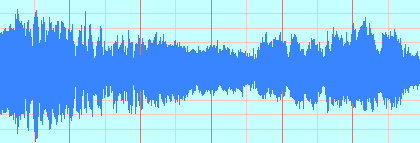 POSTPRODUCTION - the Product - being creative and an engineer
POSTPRODUCTION - the Product - being creative and an engineer
POSTPRODUCTION TEAM - DIRECTOR in charge of POSTPRODUCTION with SOUND EDITOR with team
or DIRECTOR creating the POSTPRODUCTION alone as SOUND EDITOR
DIALOGUE EDITOR + ATMOS + FXS + special FXs + 'Mise-en-scène'
THREE PHASES OF PRODUCTION - PRE-PRODUCTION, PRODUCTION, POSTPRODUCTION
OVERALL TASKS OF POSTPRODUCTION
| Working on the final PRODUCT - delivering the PRODUCT |
| You are at your most creative here. You show a skill in communication and a flair for style. |
| This also involves a lot of computer labour. You are a sound engineer, moving sound files around, cutting and pasting. |
| You create convincing, coherent play scenes. The listeners are not made aware of the PRODUCTION that went into them. |
| STORYTELLING: You bring the narrative to life. You focus the listeners' attention. You boost their emotions. |
| STRUCTURE: You design the characters' journeys through the play. You link their narrative arcs. |
|
TEAM |
|
DIALOGUE EDITING - assemble scenes with dialogue only at first ('dry' scenes) |
|
SOUND EFFECTS EDITING - assemble FXs, atmoses, special effects, creative design |
| MIXING - dialogue and effects put together, timing co-ordinated for scenes |
| (SOAP - SERIAL DRAMA) Episodes exactly timed + SIG (see BELOW) |
| Music - choices - music - underscoring, signature tune (for soap or play), emotional, dramatic |
| Action scenes - Montages - Special FXs |
| SCENE BOUNDARIES - the scenes come together - Scene boundaries - 'hard' into / 'soft' into - silence - music bridge and Scene boundaries - CHART FOR CHOICES |
| Overall rhythm of scenes and scene boundaries - 'through composed', cross-fades, music bridges, 'Archers' fade, silences - excitement, energy, pauses |
FIRST STEP - from PRODUCTION -
CREATING THE POSTPRODUCTION TEAM UNDER THE SOUND EDITOR (POSTPRODUCTION)
ONE-OFF RADIO PLAY or PROJECT
SOAP (SERIAL DRAMA) GROUP OF DIRECTORS - SOUND EDITORS
| Form the POSTPRODUCTION TEAM - here are the TASKS and RESPONSIBILITIES (depends on resources) |
| SOUND EDITOR -overall control of POSTPRODUCTION (DIALOGUE EDITOR + CREATIVE DESIGN) |
| DIRECTOR - overall control of PRODUCTION (may become SOUND EDITOR) |
 PRODUCER
- responsible for the business side of radio drama production,
budgets, contracts, delivering the product PRODUCER
- responsible for the business side of radio drama production,
budgets, contracts, delivering the product |
| TECHNICAL ASSISTANTS - collecting and co-ordinating all material from PRODUCTION, and POSTPRODUCTION tasks |
| DIALOGUE EDITING - editing takes, assembling scenes, STANDARDIZING FILE NAMES |
| SOUND EFFECTS - |
|
Editing, dubbing, adding FXs, balancing, normalising levels across the whole PRODUCT |
| (1) DIRECTOR in charge of PRODUCTION becomes SOUND EDITOR in charge of POSTPRODUCTION (one person operation) + PRODUCER (business organisation) (tightest budget - greatest artistic control) |
| (2) TEAM WORK: DIRECTOR (PRODUCTION) + SOUND EDITOR (POSTPRODUCTION) + technical assistants |
| SOUND EDITOR has overall control. |
| (SOAP - SERIAL DRAMA) GROUP OF DIRECTORS-SOUND EDITORS CO-ORDINATING (BELOW) |
SECOND STEP - TEAM TASKS (POSTPRODUCTION)
|
PRODUCER: Final budget work - payment for contracts - marketing the PRODUCT - publicity - preventing overruns or delays - allocating computer resources - solving issues between DIRECTOR and SOUND EDITOR |
|
TEAM SOUND EDITOR: Allocate scenes for POSTPRODUCTION among TEAM. |
|
SOUND EDITOR with TEAM: Collect and co-ordinate the sound files from PRODUCTION. Load this material for POSTPRODUCTION. |
| EVERYONE'S RESPONSIBILITY: Ensure STANDARDIZING FILE NAMES - efficient system, as film for every scene |
|
EVERYONE'S RESPONSIBILITY: Archive of FXs, music, special FXs, atmoses in SOUND BOX. Continual additions of sound files to SOUND BOX. Ensuring the security of sound files and that these do not become lost or corrupted. Backup of SOUND BOX. |
|
MUSIC EVERYONE'S RESPONSIBILITY: Editing, dubbing, adding FXs, balancing, music, normalising levels across the whole PRODUCT |
|
EVERYONE'S RESPONSIBILITY: Dialogue editing under DIALOGUE EDITOR = SOUND EDITOR |
|
CO-ORDINATION: POSTPRODUCTION SCRIPT (BELOW) |
| CO-ORDINATION: scenes in same locations across TEAM - repeated sound pictures (scenes) |
| CO-ORDINATION: TECHNICAL POINTS as phone call protocols, particular FXs co-ordinated across the production |
| CO-ORDINATION: logic problems, etc. |
| CREATIVE: special effects, montages, moods - as 'spaceship passing a black hole', 'travelling through time' |
how to do POSTPRODUCTION EDITING
SCENE BOUNDARIES - beginning and ending scenes - your choices
| STRAIGHT CUT | FADE INTO | FADE OUT | CROSSFADE |
| 'ARCHERS' FADE - fade out to silence (2 seconds or less) and fade in the new scene | |||
| Music bridge and music FX | FX (sound effect) bridge | ATMOS BRIDGE | MONTAGE |
| Non-realist and 'art' pieces - other techniques | |||
The cut and the fade offer different rhythms to the overall play - potentially:
| CUT - 'STRAIGHT INTO' or 'STRAIGHT OUT OF' (instantaneous change) - the scene starts straight in or ends suddenly |
| FADE or DISSOLVE - the scene dialogue is faded IN / OUT. You choose how gradually (SLOWLY) or how quickly (STEEPLY). |
| FADE IN SLOWLY - new scene begins with the dialogue being gradually heard, and then up to the required level for conversation. (But this is all within a few seconds.) Ditto FADE OUT SLOWLY. |
| FADE IN STEEPLY - new scene begins with the dialogue being speedily heard. Ditto FADE OUT STEEPLY. |
| TASKS OF DIALOGUE EDITING: |
| ASSEMBLING THE DIALOGUE PREMIX: Cleaning up the assembled and edited FINAL TAKES. Removing noises. Replacing bits of dialogue from alternate takes. Organising and smoothing. Ensuring better stereo. |
| EDITING INTO SCENES: |
EXAMPLE - SOAP (SERIAL DRAMA) -
GROUP OF DIRECTORS CO-ORDINATING
| G: Discover problems to be solved ahead. Note these in the PRODUCTION SCRIPT. |
| Examples of co-ordinating scenes, from 'The Canterbury Vampires' - the Vampires live in tunnels. Each of these underground locations has to be given the same individualising sound picture, as the Vampire Boss in his lair (12.2), the different acoustic of the prison cells (14.4), workshop (16.3). Ditto the scenes across the university campus - lecture room (Professor Williams) (6.11), student dining hall (6.1), students' individual rooms. And the outside scenes. |
| STANDARDIZING FILE NAMES - efficient system, as film |
|
A lot of cleaning-up is involved. Your notes from PRODUCTION are crucial, finding the best takes, going to what needs to be done. |
| POSTPRODUCTION SCRIPT: This is more detailed than the PRODUCTION SCRIPT. You have made all the notes you needed onto the PRODUCTION SCRIPT. (Hence the importance of putting as many technical notes as possible in the PRODUCTION SCRIPT.) |
| In additional hand notes, or preferably, by reworking the SCRIPT on the computer, create the more detailed POSTPRODUCTION SCRIPT. |
KEEP ON TARGET - ADAPT - PROBLEM SOLVING
BUILDING THE SCENES & RADIO PLAY
BUILDING THE SCENES AND THE EPISODE (SOAP - SERIAL DRAMA)
| SIG - Music signature tune for the top and bottom of each episode = sig tune |
| PLACE THE 'SIG INTRO' AND THE 'SIG OUTRO' at the beginning and end of the EPISODE (soap - serial drama). These are the TOP and BOTTOM) of the episode. This gives you the boundaries. You have to stay within these, absolutely. Each episode has to last exactly the same time. |
 'SIG INTRO' AND
THE 'SIG OUTRO' give you what you have to achieve. You see this
visually on the screen. 'SIG INTRO' AND
THE 'SIG OUTRO' give you what you have to achieve. You see this
visually on the screen. |
| CREATE A FOLDER FOR EACH SCENE OR EPISODE (SOAP). Put into this copies of all the FXs you need. |
BEING CREATIVE - THE RHYTHM OF A SCENE AND THE EPISODE (SOAP - SERIAL DRAMA)
| POSTPRODUCTION: You can create much more than the SCRIPT and PRODUCTION. |
| Only so much can be put into the SCRIPT. It is only in POSTPRODUCTION that you can fully realise the rhythm of a scene, and bring all the elements together. |
| You can experiment with the different elements of the architecture of the whole. |
NARRATIVE ARC FOR EACH OF THE MAIN CHARACTERS
EDIT POINTS - edit-friendly points for POSTPRODUCTION (CHANGEOVERS)
|
DIALOGUE EDITING: |
| Has to be done at the dialogue editing stage |
| Before the atmos is laid under the dialogue |
| Before the music |
| Think about in the PRODUCTION takes. |
| Take especial care in OB |
Marketing, web site, relations with the listeners, pod-casting?, legal aspects,
logging copyright information especially about music on the web site
Advice - Your work as a radio drama director
|
|
 EDITING
EDITING DIALOGUE
DIALOGUE SOUND
BOX
SOUND
BOX
 SCRIPT
SCRIPT



